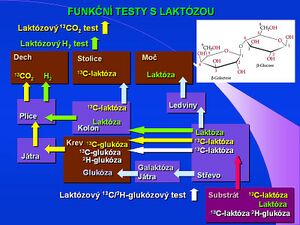Lactose tolerance test
Lactose tolerance test, 13C-lactose breath test, H2-test[edit | edit source]
The lactose tolerance test is an indirect measure of the activity of intestinal lactase, an enterocyte brush border enzyme, that hydrolyzes lactose to glucose and Galactose. The lactose test for the differential diagnosis of malabsorption syndrome - lactose intolerance - was classically performed by evaluating blood glucose levels at 15, 30, 60 and 90 minutes after oral administration of 50 g of lactose in 500 ml of water. Evidence of lactase deficiency is an increase in blood glucose by less than 1 mmol / l. The lactose test can also be evaluated more recently by breath tests, such as the H2 test, in which the concentration of hydrogen in exhaled air rises due to bacterial decomposition of undigested lactose in the large intestine, or by detecting 13C carbon after administration of labeled 13C-lactose. The combined method 13C/2H2-lactose test provides very accurate results, when the enzymatic cleavage of lactose is evaluated (the marker is 13C carbon) and at the same time as a correction of motility, bacterial cleavage in the large intestine is used (marker is H2). Diagnosis of lactose intolerance can also be supplemented by DNA by determining a specific genotype - variant 13910 T / C. Combinations of two isotope markers can also be used to increase the reliability of the test. Recent studies recommend a combined test with intestinal permeability intestinal permeability - LDI / SAT index. The lactose test is performed by administering 25 g of 13C-lactose + 0.5 g of 2H2-glucose, detection of 13C-glucose by GC / C / IRMS; 2H2-glucose GC / MS, permeability is performed by administration of 5 g lactulose and 1 g L-rhamnose, urinary sugar levels are determined by GC method. Diagnosis of lactose intolerance can also be performed by a rapid test from a duodenal biopsy. The rapid test is technically similar to the CLO-rapid test for the diagnosis of Helicobacter pylori. The incubation medium in the biopsy insertion chamber comprises the enzymes glucose oxidase and peroxidase, and a chromogenic redox substrate, the test time being 20 minutes.
Links[edit | edit source]
Sources[edit | edit source]
- KOCNA, Petr. GastroLab : MiniEncyklopedie laboratorních metod v gastroenterologii [online]. ©2002. The last revision 2011-01-08, [cit. 2011-03-04]. <http://www1.lf1.cuni.cz/~kocna/glab/glency1.htm>.
References[edit | edit source]
- ARGNANI, F. , et al. Hydrogen breath test for the diagnosis of lactose intolerance, is the routine sugar load the best one?. World J Gastroenterol. 2008, vol. 14, no. 40, p. 6204-7, ISSN 1007-9327. PMID: 18985811.
- WAUD, JP. , et al. Measurement of breath hydrogen and methane, together with lactase genotype, defines the current best practice for investigation of lactose sensitivity. Ann Clin Biochem. 2008, vol. 45, p. 50-8, ISSN 0004-5632 (Print), 1758-1001 (Electronic). PMID: 18275674.
- OJETTI, V. , et al. Quick test: a new test for the diagnosis of duodenal hypolactasia. Dig Dis Sci. 2007, vol. 53, no. 6, p. 1589-92, ISSN 0163-2116 (Print), 1573-2568 (Electronic). PMID: 17932760.
- SZILAGYI, A. , et al. Comparison of a real-time polymerase chain reaction assay for lactase genetic polymorphism with standard indirect tests for lactose maldigestion. Clin Gastroenterol Hepatol. 2007, vol. 5, no. 2, p. 192-6, ISSN 1542-3565 (Print), 1542-7714 (Electronic). PMID: 16876487.
- DI CAMILLO, M. , et al. Hydrogen breath test for diagnosis of lactose malabsorption: the importance of timing and the number of breath samples. Can J Gastroenterol. 2006, vol. 20, no. 4, p. 265-8, ISSN 0835-7900. PMID: 16609755.
- BODLAJ, G. , et al. Genotyping of the lactase-phlorizin hydrolase -13910 polymorphism by LightCycler PCR and implications for the diagnosis of lactose intolerance. Clin Chem. 2006, vol. 52, no. 1, p. 148-51, ISSN 0009-9147 (Print), 1530-8561 (Electronic). PMID: 16391332.
- KOETSE, HA. , et al. Low lactase activity in a small-bowel biopsy specimen: should dietary lactose intake be restricted in children with small intestinal mucosal damage?. Scand J Gastroenterol. 2006, vol. 41, no. 1, p. 37-41, ISSN 0036-5521 (Print), 1502-7708 (Electronic). PMID: 16373274.
- STELLAARD, F. Use of dual isotope tracers in biomedical research. Isotopes Environ Health Stud. 2006, vol. 41, no. 3, p. 275-86, ISSN 1025-6016 (Print), 1477-2639 (Electronic). PMID: 16126523.
- HÖGENAUER, C. , et al. Evaluation of a new DNA test compared with the lactose hydrogen breath test for the diagnosis of lactase non-persistence. Eur J Gastroenterol Hepatol. 2005, vol. 17, no. 3, p. 371-6, ISSN 0954-691X (Print), 1473-5687 (Electronic). PMID: 15716664.
- VONK, RJ. , et al. Lactose intolerance: analysis of underlying factors. Eur J Clin Invest. 2003, vol. 33, no. 1, p. 70-5, ISSN 0014-2972 (Print), 1365-2362 (Electronic). PMID: 12492455.
- CASELLAS, F. , et al. Applicability of short hydrogen breath test for screening of lactose malabsorption. Dig Dis Sci. 2003, vol. 48, no. 7, p. 1333-8, ISSN 0163-2116 (Print), 1573-2568 (Electronic). PMID: 12870791.
- MURPHY, MS. , et al. Use of the lactose H2 breath test to monitor mucosal healing in coeliac disease. Acta Paediatr. 2002, vol. 91, no. 2, p. 141-4, ISSN 0001-656X. PMID: 11951999.
- VONK, RJ. , et al. The 13C/2H-glucose test for determination of small intestinal lactase activity. Eur J Clin Invest. 2001, vol. 31, no. 3, p. 226-33, ISSN 0014-2972 (Print), 1365-2362 (Electronic). PMID: 11264650.
- STELLAARD, F. , et al. 13C-carbohydrate breath tests: impact of physical activity on the rate-limiting step in lactose utilization. Scand J Gastroenterol. 2000, vol. 35, no. 8, p. 819-23, ISSN 0036-5521 (Print), 1502-7708 (Electronic). PMID: 10994620.

